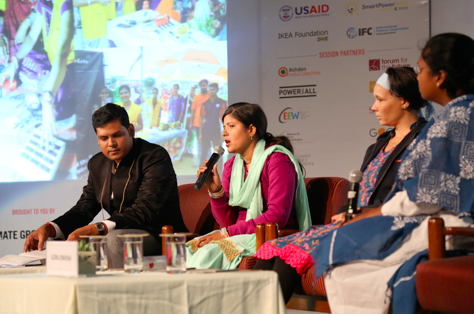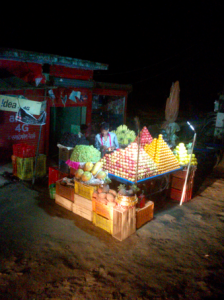Micro-electricity holds its position in the country of hundreds of millions of energy poor people

This text was published on the New Global blog 13.03.2018.

Figure: Poonam, a Solar Saheli from Rajasthan. Photo: The Climate Group
India Energy Access Summit 2018 in February in New Delhi gathered hundreds of people working with cleaner fuels and improved energy access for hundreds of millions of energy poor households in India. The speeches and panel sessions touched on energy financing, technologies, policy and social aspects. A consultant presentation forecasted increases in solar lantern sales and a donor organization promised more funds for energy access projects. Bankers discussed financing models.
Voice was given also for women practitioners, often overlooked. As India is a traditional society where women often stay at home taking care of children and preparing food; and thus forming an important energy user group, Still energy providers and entrepreneurs are mainly men. Barefoot College and Frontier Markets are exceptions to this rule and were invited to stage. These initiatives educate women all around the developing world as “solar mamas” and “solar sahelis” who are able construct, maintain and distribute solar systems in their communities.
For me, as well as for the majority of the participants, this event was the arena for meeting collaboration partners and to network. I am a doctoral student having since 2015 researched how small renewable energy technologies perform in Indian villages, in actual environments where they are being used. Currently, I am in the process of interviewing as many Indian micro-grid utilities and entrepreneurs for their technologies, as I can reach. The summit was a must for me to meet these people and to organize interviews. After the summit I took two weeks for visiting micro-grid installations around Northern India. More information on my research is available on my website.
Seems like the micro-grid companies in India are in a pending phase. A flagship program of the government is the Saubhagya scheme, under which the distribution grid is expanded to all non-electrified households by the end of 2019. In this program, the role of micro-grid electricity remains unclear. This unclarity in the legal status was articulated in the Summit presentations of the energy entrepreneurs, sometimes bursting out as desperation, as administrative burdens – for example in gaining permits – can be unbelievable astounding.
However, it was rather surprising that the foreseeable effects of the scheme were not much discussed at the Summit sessions. If all households were to be connected, what would remain for the off-grid electrification companies to do anymore? Maybe it went without saying that the scheme is merely a political target and not an implementation plan? Some people I have interviewed have laughed and said that, of course, there will always be non-electrified and under-electrified valleys between the electrified hubs. An aged and inefficient power distribution infrastructure can never host the millions of under-electrified households without a thorough renewal. Power quality and regular blackouts are also a great problem.
There is plenty of room for micro-grid electricity companies to work in also in the future, not only as back-up power providers. I hope the renewal of the grid infrastructure would be done in cooperation with micro-electricity providers. The opportunities in building up a reliable and inter-connected smart grid are huge for India.

Figure: Street vendor by night in Uttar Pradesh using a mobile street lamp. Photo: Sini Numminen
Sini Numminen
Doctoral Student at Aalto University (Tiina ja Antti Herlin Foundation)
Travel Grants: UniPid FinCEAL+ and TEKES New Global